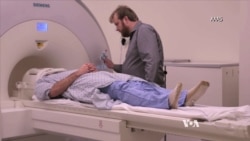People who suffer from chronic pain are sometimes met with skepticism because medical tests can’t conclusively prove the existence of such discomfort, but now new methods for mapping pain in the brain not only validate sufferers of chronic pain but might someday also lead to better treatment.
Chronic pain, that lasts for months and years, afflicts one out of every five people. It can lead to lost jobs, depression, and rising despair when medical interventions fail or health experts hint that a pain sufferer is making it up. At a support group in Boulder, Colorado, chronic pain sufferers commiserate about the responses they've all heard.
“Docs don’t seem to understand what’s going on," says Charles Horowitz, the leader of the group, who has chronic back pain. "First they say, well let’s try this, let’s try that.” One of the women in the group interjects “. . . if you’re lucky.” Horowitz nods and says, “Sooner or later, they’re probably going to say, uh, I think you need to see a psychiatrist or a psychologist.”
But a session with Harvard researcher Clas Linnman may be more productive.
Using Positron Emission tomography to map inflammation, he has been able to show that even without obvious tissue damage, people who report whiplash pain have more inflammation in their necks. For the pain of tennis elbow, the inflammation is near the elbow.
“A lot of patients are met with skepticism that, 'Ah, it’s probably nothing and you’re just complaining,' but we’re trying to get a good objective marker of the ongoing suffering these patients experience.”
Brain imaging from University of Colorado scientist Tor Wager shows differences between long term and sudden pain. Sudden pain, such as touching a hot plate, triggers centers in the brain that govern fast action - like pulling your hand away. Pointing to MRI images, he explains that the pain signaling goes to many places in the brain at once.
In contrast, chronic pain activates brain areas tied to emotion and memories, and what Wager calls, “caring.”
“So when we have people experience this hot stimulus and then imagine that it’s burning your hand, bubbling, blistering, [the pain] gets worse."
But when they focused on calming images instead, such as a warm blanket on a cool day, Wager says the “caring” centers lit up, and the pain eased.
"Your ability to work with pain, mentally, can have effects on how this system amplifies or diminishes pain.”
This makes sense to Horowitz, which is why these days he spends more time with friends, as one form of “re-framing” pain. And he is a big fan of meditation. He is hopeful that in the years ahead, discoveries from researchers mapping the brain will help identify just what therapies work best for each sufferer, and lead more people out of the tangle of chronic pain.





